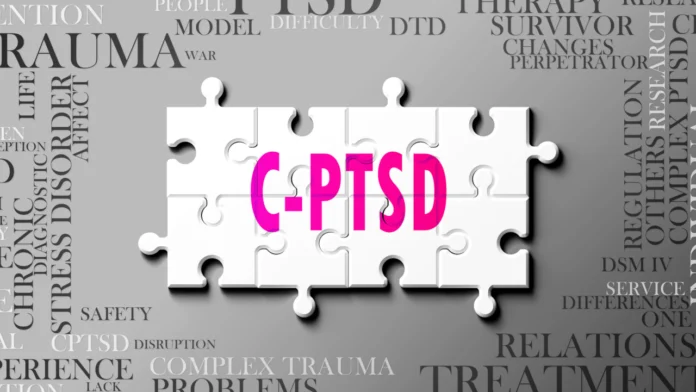What Is Complex PTSD (CPTSD)?
CPTSD stands for complex post-traumatic stress disorder. CPTSD shares most symptoms with PTSD, but also includes more specific symptoms. Complex trauma PTSD typically arises from prolonged or repeated trauma like childhood abuse or domestic violence, rather than an isolated traumatic event.
Therapy.com is user supported. We receive a commission fee from purchases made through BetterHelp links.
Learn More
Complex PTSD vs PTSD: Key Differences
While both diagnoses are very similar, there are some key differences between CPTSD vs PTSD in terms of symptoms, causes, and diagnosis criteria.
PTSD can result from a single traumatic event and include some symptoms like flashbacks, panic attacks, avoidance of triggers, and intrusive thoughts.
CPTSD results from ongoing or repeated trauma, not just a one-time event. Complex PTSD includes the core symptoms of PTSD but also include emotional dysregulation, negative self-perception, and relationship difficulties.
What Are the 17 Symptoms of Complex PTSD?
Complex post-traumatic stress disorder does not have its own distinct diagnosis in the current DSM-5, the diagnostic manual that psychiatrists use to diagnose mental health conditions. Instead, it is considered to be a type of PTSD. The International Classification of Diseases (ICD-11) does have a list of symptom criteria for CPTSD, though.
The 17 CPTSD symptoms are broken down into three different categories.
First, there are cognitive and physical symptoms. These include:
- Negative self-perception: Feeling broken or unworthy of love
- Difficulty concentrating: Struggling to focus on tasks or conversations
- Sleep disturbances: Having nightmares or trouble falling or staying asleep
- Chronic fatigue: Feeling exhausted even when you get enough sleep
- Physical symptoms: Experiencing headaches, digestive issues, or muscle tension that can’t be explained otherwise
The next category is emotional and psychological symptoms, which are:
- Persistent sadness or depression: Feeling hopeless and emotionally exhausted
- Difficulty regulating emotions: Experiencing intense mood swings or outbursts
- Chronic anxiety: Dealing with constant fear, nervousness, or worry
- Guilt or shame: Having a deep sense of brokenness or self-blame
- Flashbacks or intrusive thoughts: Reliving the traumatic events through unwanted memories
- Dissociation: Feeling detached from yourself or reality
- Hypervigilance: Always feeling on edge or looking out for danger
Finally, there are also interpersonal symptoms and these include:
- Avoiding people, places, or situations that remind you of your trauma
- Self-isolating and withdrawing from friends and family
- Participating in self-destructive behaviors such as substance misuse, reckless activities, or self-harm
- Having difficulty trusting others and struggling to build meaningful relationships
- Being irritable or having sudden outbursts of aggression
Therapy.com is user supported. We receive a commission fee from purchases made through BetterHelp links.
Learn More
How Therapy Can Help Heal Complex Trauma
Several different therapeutic approaches can help you heal from the complex trauma that causes CPTSD. Having a trained professional guide you through the process is essential, since talking about traumatic experiences can be difficult and can re-traumatize you if it’s not done with expert care.

When recovering from complex trauma, long-term therapy is often recommended. Some of the benefits that come from engaging in trauma therapy over a long period include:
- Improved emotional regulation
- Reduced anxiety-related symptoms
- Increased trust in self and others
- Recovery of lost identity
Once you get assessed by a mental health professional, they will make a treatment plan for you. There are several different therapeutic approaches they may take or they might integrate multiple techniques together. The most common therapies for CPTSD are EMDR, trauma focused CBT, and somatic experiencing.
EMDR
EMDR stands for eye movement desensitization and reprocessing, and it’s a technique that can be very effective in recovering from trauma.
A trained EMDR therapist will use some type of bilateral stimulation, which means that they alternate between stimulating the right and left sides of your brain. This is usually done with simple motions like eye movements, tapping, or sounds, and you’ll do this while you recall traumatic events.
The stimulation helps your brain process and reprocess the traumatic memory, reducing its intense negative effects on your brain and emotional system. Often, therapists will start with less traumatizing events to help you get used to the process before moving on to more intense memories.
When utilizing EMDR for complex PTSD, your therapist will use what is called a phased approach. This means you will spend some time learning how to stabilize and use coping skills first before diving into traumatic memories.
Therapy.com is user supported. We receive a commission fee from purchases made through BetterHelp links.
Learn More
Trauma-Focused CBT
Trauma-focused cognitive behavioral therapy or TF-CBT is an approach to therapy that is uniquely designed for children and adolescents who have gone through trauma. Some of the things you can expect from this approach include:
- Psychoeducation for a child and caregiver to better understand trauma and the impact it has on young people
- Learning coping skills that will aid in emotional regulation, such as relaxation techniques and deep breathing
- Telling and processing your trauma story
- Gradual exposure to triggers that prompt unpleasant symptoms so you can progressively learn how to manage your responses
- Practicing coping skills
An important part of TF-CBT is the involvement of the caregiver in the therapeutic process. It can be difficult for caregivers to know how to respond to trauma-induced behaviors, and learning the best ways to support your child as they recover sets them up for the best healing journey possible.
Somatic Experiencing
Somatic experiencing (SE) is a therapy approach that focuses on the body, helping you release tension and trauma stored in your body. The theory behind SE is that emotions and trauma are stored in our body and manifest through various physical symptoms.
While other forms of therapy focus on the mind, this approach aims to raise your awareness of bodily sensations and teach you to feel safe in your body while exploring your traumatic memories and the feelings that come with them.
Some of the techniques used in SE include:
- Acupressure
- Hypnosis
- Breathwork
- Dance
- Body awareness
- Pendulation (moving from a relaxed state toward emotional states, then back to relaxation)
- Titration (guiding through a traumatic memory while noting any physical sensations at the same time)
Taking the First Step: CPTSD Tests and Getting Help
If you are concerned that you or a loved one may have CPTSD, you can receive an official assessment from a licensed healthcare provider. From there, a mental health professional can guide you toward a treatment plan that best suits your specific needs.
For instance, your healthcare provider may recommend talk therapy, medications such as selective serotonin reuptake inhibitors (SSRI), or a combination of both.
Keep in mind, however, that you don’t have to pursue a diagnosis to get effective treatment because a mental health professional can treat you without a diagnosis.
If you are unsure of where to find help, you can talk to your doctor or find a licensed trauma therapist near you through Therapy.com. Help is available, and early diagnosis and treatment will help you recover and experience relief.
Therapy.com is user supported. We receive a commission fee from purchases made through BetterHelp links.
Learn More
